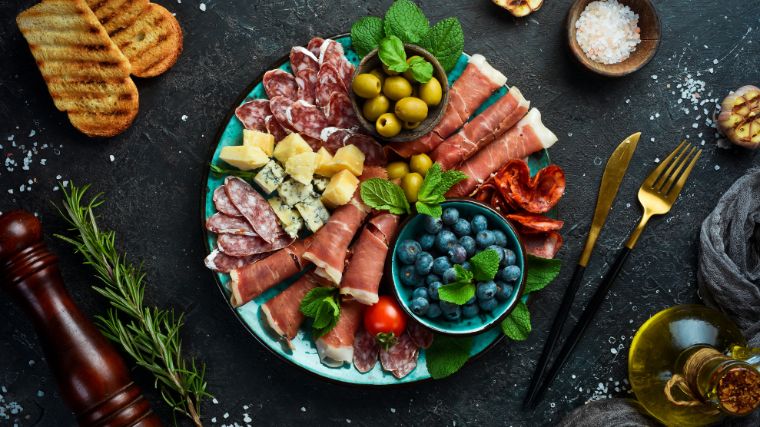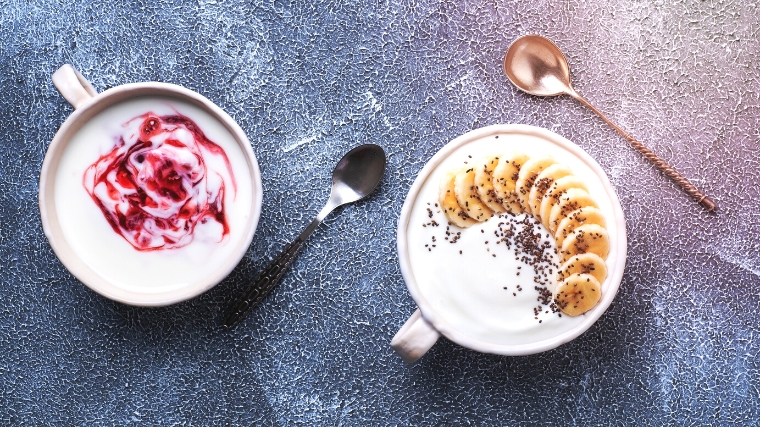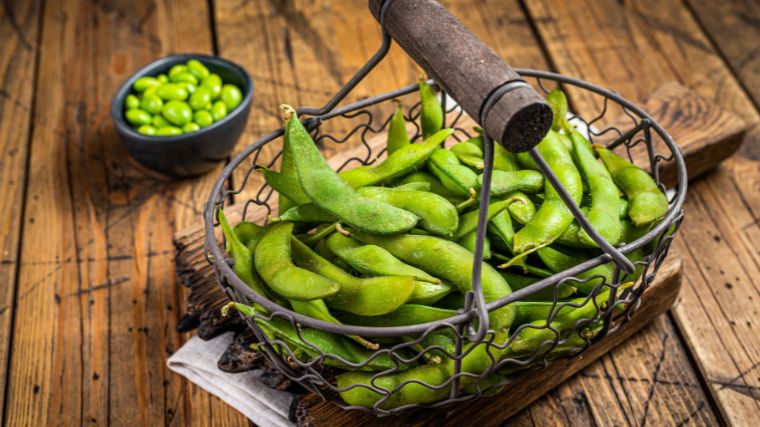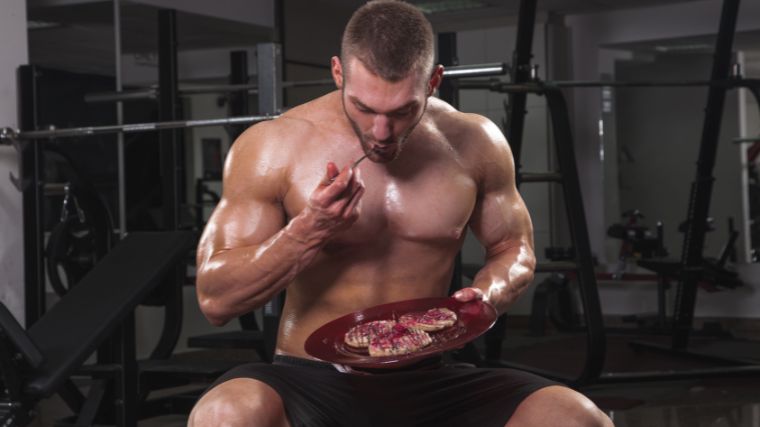Whether you’re trying to stick to bulk up, are living a busy lifestyle, or just getting hungry between lunch and dinner time, you’ve probably reached for a filling snack to keep you going. Having some snack options on hand can help you stick to your goals, and high-protein snacks will help you stay satisfied — and muscular.
Choosing healthy snacks that are high in protein can also help you hit your protein intake goals. Getting enough protein is essential when you’re aiming to gain muscle, recover from workouts, strengthen your bones, and even lose body fat.

Here are the 10 best healthy high-protein snacks so you can be prepared when the cravings hit. We’ll also outline how much protein you need for all your fitness goals and get into all the benefits of protein.
Editor’s Note: The content on BarBend is meant to be informative in nature, but it should not be taken as medical advice. When starting a new training regimen and/or diet, it is always a good idea to consult with a trusted medical professional. We are not a medical resource. The opinions and articles on this site are not intended for use as diagnosis, prevention, and/or treatment of health problems. They are not substitutes for consulting a qualified medical professional.
- 10 High-Protein Snacks
- How Much Protein Do You Need?
- The Benefits of Protein
- Frequently Asked Questions
10 High-Protein Snacks
Hungry between meals? There are the 10 best healthy snacks made up of high-protein foods and their macronutrient info. They’re quick, nutrient-dense, and you can take them on the go.
All nutritional information comes from the FoodData Central page on the United States Department of Agriculture (USDA) website. (1)
- Greek Yogurt
- Cottage Cheese
- Hard-Boiled Eggs
- Deli Meat Roll-Up
- Beef Jerky
- Edamame
- Quinoa
- Hummus
- Homemade Trail Mix
- Protein Shake
Greek Yogurt
Yogurt has always been a popular snack for people looking for something low in calories. Greek yogurt can be an even better option because it’s high in protein and will keep you fuller for longer. It’s also a great source of calcium, and you can get a non-dairy version if you don’t eat dairy.
For extra flavor, add a handful of blueberries to get some antioxidants. You may also want to add nut butter for healthy fats or granola for a crunch. Top with chia seeds, hemp seeds, or pumpkin seeds for an extra protein boost.

[Read More: Nutrition for Athletes — How to Eat for Muscle and Performance]
One 200-gram serving of low-fat Greek yogurt packs 20 grams of protein, 3.8 grams of fat, and 7.9 grams of carbs. Toppings will increase the calories, but they’ll help keep you satisfied.
Cottage Cheese
Cottage cheese is another dairy option high in calcium and packed with protein. It’s recently become popular on social media because it’s so versatile, and you can add it to recipes to boost the protein content. To keep it quick and simple, you can have it on its own, add some blueberries, or pair it with an apple.
A 113-gram serving of low-fat cottage cheese has 14 grams of protein, one gram of fat, and three grams of carbs.
Hard-Boiled Eggs
Hard-boiled eggs are a super easy addition to your meal prep plans, so you have them ready for a quick and satisfying snack. Eggs contain many nutrients, including B vitamins. If you only like egg whites, removing the yolk is easy enough.
One large egg contains six grams of protein, five grams of fat, and 0.5 grams of carbs. One egg on its own isn’t a huge source of protein, so you might want to have two or three for a more filling snack.
Deli Meat Roll-Up
If you’re a meat eater, deli meat makes a great quick snack. Sliced turkey breast is a healthy, high-protein choice. Grab a few slices, roll them up, and you’re good to go. You can also add in a string cheese for some extra protein. Turkey roll-ups are a low-carb option, but you can put your turkey and cheese on a whole-grain wrap to add healthy carbs.
One slice of turkey breast has six grams of protein, 0.2 grams of fat, and 0.9 grams of carbs. Three slices will get you close to 20 grams and make you feel more satisfied. Adding in a low-fat string cheese will give you an extra seven grams of protein, 5.7 grams of fat, and one gram of carbs.
Beef Jerky
Jerky is a super convenient and healthy high-protein snack. It’s made from meat that has been processed and dried. Some brands have a ton of additives, so you may want to read the label and look for one with minimal ingredients. You can also make your own. You can easily find beef, turkey, salmon, or chicken jerky in most local bodegas or grocery stores.
A one-ounce serving of beef jerky contains 9.4 grams of protein, 7.4 grams of fat, and three grams of carbs.
Edamame
Edamame beans are a form of soybeans packed with protein and other nutrients, including vitamin K and folate. They’re a type of legumes which are a good source of healthy carbs. You can make them quickly in the microwave, add some seasoning, and enjoy. Edamame is an excellent option for vegan athletes looking for a high-protein snack.

[Read More: The 12 Best Vegan Protein Powders]
A one-cup serving of edamame yields 18 grams of protein, eight grams of fat, and 13.8 grams of carbs.
Quinoa
Quinoa is a gluten-free, whole-grain, plant-based protein. It can be part of a healthy meal, but you can also make a quick cup for a filling snack. Add a little olive oil for some healthy fats.
A one-cup serving of quinoa has 8.1 grams of protein, 3.5 grams of fat, and 39.4 grams of carbs. It also has five grams of fiber that will help keep you full.
Hummus
Hummus on its own isn’t the highest protein source, but it has other health benefits — and it’s easy to add other proteins to the mix. This popular spread is made from chickpeas, which are legumes that contain fiber and healthy fats that will fill you up.
Add string cheese to your snack for some extra protein on the side, or spread some hummus on your turkey roll-up. You can dip veggies in hummus to get some more nutrients as well.
A 100-gram serving of hummus contains 7.3 grams of protein, 17 grams of fat, and 15 grams of carbs. It also has 5.4 grams of fiber.
Homemade Trail Mix
Make your own trail mix for a delicious protein-rich snack to take on the go. You can choose ingredients with the highest protein content, like almonds, pistachios, cashews, and pumpkin seeds. Almonds also contain antioxidants, pistachios are high in essential amino acids, and pumpkin seeds contain fiber. They all have healthy fat as well.
[Read More: The Best Foods for Energy Before, During, and After Your Workouts]
You can also add dark chocolate or chocolate chips to your trail-mix for more antioxidants.
You probably won’t add a whole serving of each ingredient if you’re mixing a few of them, but here’s how they all break down:
- A 28-gram serving of almonds contains six grams of protein, 14 grams of fat, and 6.1 grams of carbs.
- A 30-gram serving of pistachios yields six grams of protein, 13 grams of fat, and 9 grams of carbs.
- A 28-gram serving of cashews has 4.3 grams of protein, 13 grams of fat, and 9.2 grams of carbs.
- A 28-gram serving of pumpkin seeds has 5.27 grams of protein, 5.5 grams of fat, 15.3 grams of carbs, and 5.2 grams of fiber.
Protein Shake
Dietitians recommend reaching your protein intake goals through whole foods before adding supplements. But making a protein shake with high-quality protein powder is a convenient way to whip up a satisfying snack. The protein content makes it one of the most protein-rich snacks you can have.
You can keep it simple and mix it with water if you don’t want any added sugar. You can also use plant-based milk instead, add some peanut butter or almond butter for healthy fats, and throw in some blueberries or a banana for extra texture and nutrients.
[Read More: The Complete Guide to Pre-Workout Supplements]
Whey protein is a high-quality source of protein and is one of the best options for people who consume dairy. A one-scoop serving of whey protein packs 25 grams of protein, 0.5 grams of fat, and two grams of carbs.
Soy protein is a plant-based protein powder with similar benefits to whey if you don’t do dairy. One scoop typically yields 25 grams of protein, 2.5 grams of fat, and 13 grams of carbs.
How Much Protein Do You Need?
High-protein snacks can help fill the gaps in your day, but how much protein should you aim for? The Food and Drug Administration (FDA) states that adults need 50 grams of protein per day, but that’s the minimum requirement for bodily functions. (2)
If you’re active, you’ll probably need more than that. Your individual needs may vary based on your body, goals, and activity level. If you’ve heard one gram of protein per kilogram of body weight or one gram of protein per pound of body weight, and you’re confused by all those numbers, you’re not alone. Let’s break it down.
Start with BarBend’s protein intake calculator to get your customized recommendation.
Protein Intake Calculator
Age
Sex
Height
Weight
Goal
Activity Level
Do you know your body fat percentage?
[Read More: The 16 Best Pre-Workout Supplements]
The American College of Sports Medicine (ACSM) gives protein intake guidelines for active people. They recommend 1.2 to 1.7 grams of protein per kilogram of body weight — or 0.5 to 0.8 grams per pound. (3)
If you want to gain muscle or lose fat, let’s take it a step further.
For Muscle Growth
If you’ve heard different numbers for protein intake goals for muscle growth, it’s because there have been tons of studies trying to get the perfect number. Be sure that you’re resistance training and eating enough calories.
The ACSM lists 1.6 grams of protein per kilogram of body weight as the minimum for muscle gain, and anything over 2.2 grams may be unnecessary. The International Society of Sports Nutrition (ISSN) gives a range of 1.4 to 2.0 grams of protein per kilogram of body weight for building and maintaining muscle. (3)(4)
[Read More: The Definitive Guide to Bodybuilding Meal Prep]
Competitive bodybuilders may need to go higher. Some research shows that most (but not all) bodybuilders can gain enough muscle by having 2.3 to 3.1 grams of protein per kilogram of body weight per day. (5)
Based on this research, for a gymgoer aiming to gain muscle who isn’t competing, staying in the 1.4 to 2.2 grams of protein per kilogram of body weight may be sufficient.
For Fat Loss
If you have a weight loss goal, trying to lose fat and retain muscle by resistance training and calculating your overall calorie needs can be helpful. Your protein needs may vary slightly, whether you’re in a calorie deficit or reducing your portions. The ISSN suggests 2.3 to 3.1 grams of protein per kilogram of body weight to lose fat and retain muscle. (4)
One study was done on young cis men in a high calorie deficit (40 percent) while they were resistance training six days a week for four weeks. Half of the group consumed 1.2 grams of protein per kilogram of body weight. The other half consumed 2.4 grams of protein per kilogram of body weight.
The group consuming higher protein retained more muscle and lost more body fat than those consuming lower protein. (6)
This study is an extreme case — a high training volume and a large calorie deficit with young, active cis men. Still, it demonstrates that increasing your protein intake to at least two grams per kilogram while losing fat may be beneficial.
The Benefits of Protein
Protein, along with carbs and fat, is one of three macronutrients your body needs to function well and for overall health. (7)
When it comes to fitness, protein plays a role in building muscle, losing fat, and recovering from workouts. It may also impact your bone health. Let’s break down all the benefits of getting enough protein in your diet.
Helps Build Muscle
Protein is key to building skeletal muscle mass when paired with resistance training. This has been well-established in scientific studies for many years. While lifting weights, you’re breaking down your muscle fibers, which means that muscle protein breakdown occurs.
Outside of training, consuming protein helps repair and regenerate your muscle fibers — muscle protein synthesis occurs, leading to hypertrophy. (8)(9)

[Read More: The Best Healthy Fast Food Options at the Most Popular U.S. Chains ]
Twenty amino acids make up muscle protein: nine are essential amino acids, and 11 are non-essential. Your body needs all 20 for muscle protein synthesis and muscle growth to occur.
You need to take in essential amino acids through your diet because your body cannot produce them on its own. (10)(11)
Consuming complete protein sources like whole foods and supplements gives your body all the amino acids it needs to build your hard-earned muscle after training hard. It has a direct impact on your skeletal muscle and helps stimulate muscle protein synthesis.
Helps With Fat Loss
If your goal is fat loss, you may reduce your food intake by consuming fewer calories or smaller portions. More than carbs or fat, protein is known to increase satiety or feelings of fullness. Eating enough protein while losing fat can help you feel fuller for longer and stick to your plan. Opting for high-protein snacks can help keep you on track. (12)
High-protein diets also increase thermogenesis. Your body needs to use more energy to digest it, which slightly boosts your total daily energy expenditure (TDEE). This higher thermic effect of protein-rich foods also increases satiety. (12)
Some clinical trials also suggested that high-protein diets can boost weight loss and lower your risk of cardiovascular diseases. In trials lasting six to 12 months, high-protein diets were also able to help prevent weight regain in people who lost weight. (13)
Consuming a high-protein diet while losing body fat has also been shown to help your body preserve its lean muscle mass. It’s important to continue engaging in resistance training to help maintain your muscle mass and strength. (12)(13)
Helps With Muscle Recovery
Eating enough protein helps you recover better from your workouts. Aside from building muscle, you also need protein to repair damaged cells and tissue and to stimulate metabolic and hormonal processes. This helps improve your recovery and boost your immune function. (14)
[Read More: Omega 3 Benefits — More Muscle, Better Recovery, and Enhanced Endurance ]
If you’re recovering from an injury, some evidence shows that consuming protein also plays a role in healing. (15)
May Improve Bone Health
Beyond strong muscles, you need strong bones, especially as you age. Calcium and vitamin D are the nutrients typically associated with bone health, but protein also plays a role.
Evidence shows that consuming enough protein (and calcium and vitamin D) may be an effective nutritional strategy for osteoporosis prevention. Osteoporosis is a decline in bone mass and strength, and it’s more common in cis women as they age. (16)
It’s also important to do resistance training and weightbearing cardio to prevent or manage osteoporosis.
Snack Away
Protein is one of three macronutrients that your body needs to function properly. Aiming to hit your protein intake goals has many health benefits that can help you with your fitness goals of building muscle, losing body fat, and preserving bone health and strength as you age.
If you’re hungry for a snack, reaching for a high-protein option will help keep you full and get you closer to reaching your intake goal. Choosing from whole foods like Greek yogurt, cottage cheese, eggs, meats, cheese, and legumes gives you plenty of healthy, high-protein snacks to choose from. In a pinch, you can also whip up a protein shake with high-quality protein powder to chase those muscle gains.
FAQs
Let’s address any lingering questions you may have about high-protein snacks.
How can I get 20 grams of protein in a snack?
Greek yogurt or a protein shake can get you close to 20 grams of protein. You can also combine healthy options with less protein to get you to 20 grams. For example, two slices of turkey and a large hard-boiled egg will get you to 18. If you’re a vegan, one cup of edamame has 18 grams of protein.
What is the best protein bar?
Look for a protein bar with minimal ingredients that gets you close to 20 grams of protein. However, you can also choose one that you enjoy the most and do the math from there. Check out BarBend’s picks for the best protein bars.
What are the benefits of eating high-protein snacks?
Eating high-protein snacks promotes satiety and keeps you full during the day so you can focus and won’t be distracted by hunger. If you aim for a protein intake goal, snacks can help you get closer to it outside your meals. If you’re in a rush after a workout, a high-protein snack can help you recover and hold you over until you can eat more.
References
- USDA. FoodData Central. U.S. Department of Agriculture.
- USDA. Current dietary guidelines. Dietary Guidelines for Americans, 2020-2025.
- Rodriguez NR, DiMarco NM, Langley S; American Dietetic Association; Dietitians of Canada; American College of Sports Medicine: Nutrition and Athletic Performance. Position of the American Dietetic Association, Dietitians of Canada, and the American College of Sports Medicine: Nutrition and athletic performance. J Am Diet Assoc. 2009 Mar;109(3):509-27.
- Jäger R, Kerksick CM, Campbell BI, Cribb PJ, Wells SD, Skwiat TM, Purpura M, Ziegenfuss TN, Ferrando AA, Arent SM, Smith-Ryan AE, Stout JR, Arciero PJ, Ormsbee MJ, Taylor LW, Wilborn CD, Kalman DS, Kreider RB, Willoughby DS, Hoffman JR, Krzykowski JL, Antonio J. International Society of Sports Nutrition Position Stand: protein and exercise. J Int Soc Sports Nutr. 2017 Jun 20;14:20.
- Helms ER, Aragon AA, Fitschen PJ. Evidence-based recommendations for natural bodybuilding contest preparation: nutrition and supplementation. J Int Soc Sports Nutr. 2014 May 12;11:20.
- Longland TM, Oikawa SY, Mitchell CJ, Devries MC, Phillips SM. Higher compared with lower dietary protein during an energy deficit combined with intense exercise promotes greater lean mass gain and fat mass loss: a randomized trial. Am J Clin Nutr. 2016 Mar;103(3):738-46.
- Arentson-Lantz E, Clairmont S, Paddon-Jones D, Tremblay A, Elango R. Protein: A nutrient in focus. Appl Physiol Nutr Metab. 2015 Aug;40(8):755-61.
- Camera DM. Evaluating the Effects of Increased Protein Intake on Muscle Strength, Hypertrophy and Power Adaptations with Concurrent Training: A Narrative Review. Sports Med. 2022 Mar;52(3):441-461.
- Stokes T, Hector AJ, Morton RW, McGlory C, Phillips SM. Recent Perspectives Regarding the Role of Dietary Protein for the Promotion of Muscle Hypertrophy with Resistance Exercise Training. Nutrients. 2018 Feb 7;10(2):180.
- Watford M, Wu G. Protein. Adv Nutr. 2018 Sep 1;9(5):651-653.
- Santos CS, Nascimento FEL. Isolated branched-chain amino acid intake and muscle protein synthesis in humans: a biochemical review. Einstein (Sao Paulo). 2019 Sep 5;17(3):eRB4898.
- Paddon-Jones D, Westman E, Mattes RD, Wolfe RR, Astrup A, Westerterp-Plantenga M. Protein, weight management, and satiety. Am J Clin Nutr. 2008 May;87(5):1558S-1561S.
- Moon J, Koh G. Clinical Evidence and Mechanisms of High-Protein Diet-Induced Weight Loss. J Obes Metab Syndr. 2020 Sep 30;29(3):166-173.
- Kreider RB, Campbell B. Protein for exercise and recovery. Phys Sportsmed. 2009 Jun;37(2):13-21.
- Frankenfield D. Energy expenditure and protein requirements after traumatic injury. Nutr Clin Pract. 2006 Oct;21(5):430-7.
- Bonjour JP. Dietary protein: an essential nutrient for bone health. J Am Coll Nutr. 2005 Dec;24(6 Suppl):526S-36S.
Featured Image: YARUNIV Studio / Shutterstock
The post The 10 Best High-Protein Snacks to Help You Build Muscle and Stay Full appeared first on BarBend.

